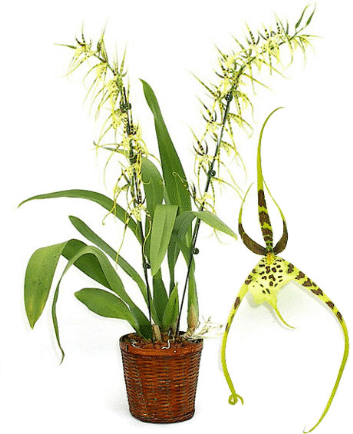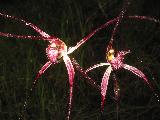What Does A Spider And A Brassia Orchid Plant Have In Common?
BRASSIA ORCHID PLANT
What do spiders and orchid plants have in common?. These plants look somewhat like spiders. Brassia orchid plant is the name given to these orchids, sometimes nicknamed "spider orchids".
Indeed, you can see the resemblance to the spider in this picture.

These beautiful orchids are from the Genus Brassia and are often called the spider orchids. The long and slender petals and sepals are a little like spider legs.
They are named in honor of William Brass, a 19th-century British botanical illustrator, this orchid grows in the wet forests of tropical Central and South America, but it is also comfortable in cultivation.
Many species in the genus Brassia are pollinated by parasitic wasps, which normally lay their eggs on spiders. The patterns and structure of Brassia orchids resemble a spider in its web enough to encourage these wasps to lay their eggs in the plants' blossoms and in doing so pollinate them.
The flower spike will provide you with a number of these flowers which do resemble spiders along the spike. Brassias are crossed with Miltonia and Ondontoglossums to produce some very pretty orchid plants. Some have flowers that reach about 10 inches in diameter.

These orchids are often extremely fragrant.
They are not hard to grow but do require some specific parameters for their growth. First, spider orchid plants do require either high intensity bright light. This can be diffuse light. They should not have the direct noon-time sunlight.
During the day and into their growth and blooming period they like temps between 65 and 75 degrees Fahrenheit (18 C. - 24 C.) At night the temperatures for the Brassia orchid plant should be between 55 and 65F. ( 13 C. - 18 C.)
Just after their blooming period these plants need a rest for several weeks. This means that the temperature should be kept on the lower end of the range, 55 - 60 degrees.
With respect to watering, they need to be kept moist but not wet during their growing season. The growing period is when the flat pseudobulbs develop and when the inflorescence (flower spike) forms.
After this period you should water only once a week.
Spider orchid plants do need both humidity and air circulation. The humidity is between 50-70%. This is a little higher than most orchids. For air circulation you can use a small fan, but don't point the fan on the plant.
This is a discussion of the culture of the spider orchids. Check here for a discussion of the culture of other popular orchids.
Return to the Top of Brassia Orchid Plant Page
Return to the Orchids-Plus-More Home Page
Home | Customer Service & Contact Information | Site Map | Security & Privacy


